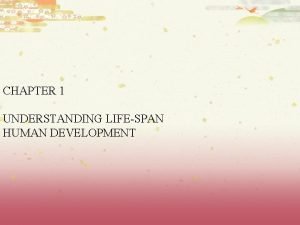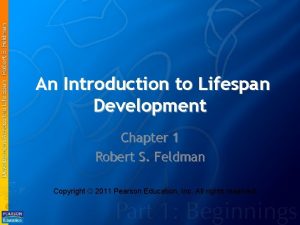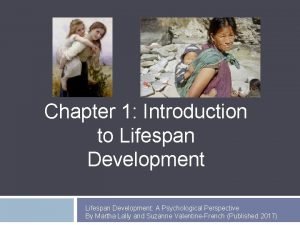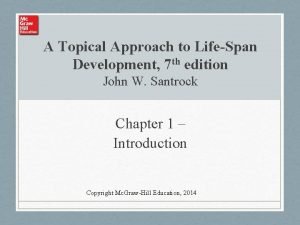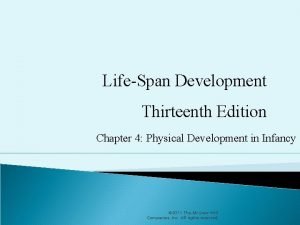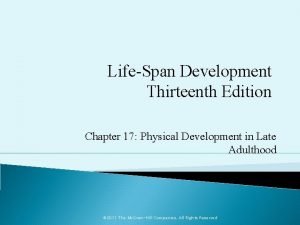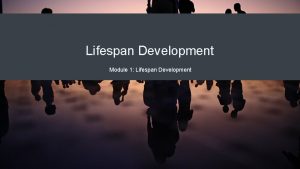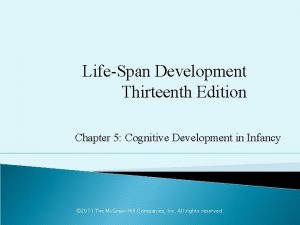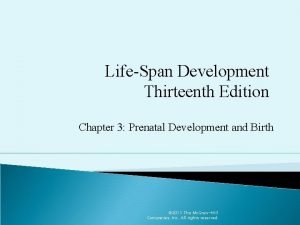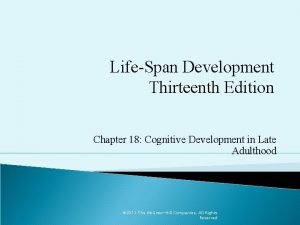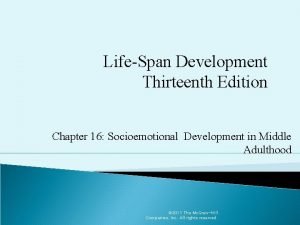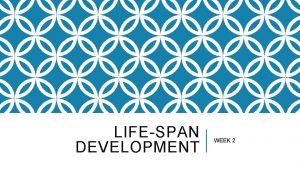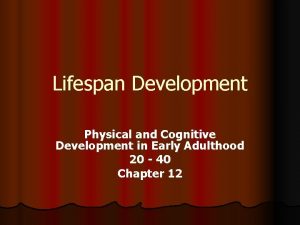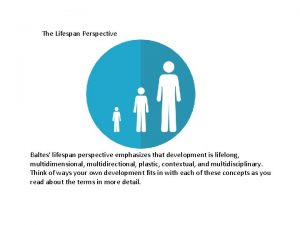LifeSpan Development Twelfth Edition Chapter 11 Physical and

























- Slides: 25

Life-Span Development Twelfth Edition Chapter 11: Physical and Cognitive Development in Adolescence © 2009 The Mc. Graw-Hill Companies, Inc. All rights reserved.

The Brain The adolescent brain undergoes significant structural changes Corpus callosum thickens; improves adolescents’ ability to process information Amygdala (handles processing of information about emotion) develops earlier than the prefrontal cortex (involved in higher -level cognitive processes) Adolescents are driven by strong emotions but have difficulty controlling these passions © 2009 The Mc. Graw-Hill Companies, Inc. All rights reserved.

Puberty Preoccupation with body image is especially strong in early adolescence • Girls are generally less happy with their bodies than boys and become more dissatisfied over time • Boys typically become more satisfied as they move through puberty Early and Late Maturation: Boys: Early-maturing boys view themselves more positively and have more successful peer relations Late maturing boys report a stronger sense of identity in their 30 s In general, early maturation seems to be better Girls: Early-maturing girls are more likely to smoke, drink, be depressed, have an eating disorder, struggle for earlier independence, have older friends, date earlier and have earlier sexual experiences

Eating Disorders Anorexia Nervosa: an eating disorder that involves the relentless pursuit of thinness through starvation ◦ Three Main Characteristics: Weighing less than 85% of what is considered normal for a person’s age and height Having an intense fear of gaining weight that does not decrease with weight loss Having a distorted image of their body shape ◦ Typically begins in the early to middle teen years, often following an episode of dieting ◦ 10 times more likely to occur in females than males ◦ Role Models and the Media: Girls who were motivated to consume media with thin, female images were more likely to report dissatisfaction with their bodies © 2009 The Mc. Graw-Hill Companies, Inc. All rights reserved.

Eating Disorders Bulimia Nervosa: eating disorder in which the individual consistently follows a binge-andpurge pattern ◦ Most bulimics: Are preoccupied with food Have an intense fear of becoming overweight Are depressed or anxious Have a distorted body image ◦ Bulimics typically fall within a normal weight range © 2009 The Mc. Graw-Hill Companies, Inc. All rights reserved.

Adolescent Sexuality • Timing of sexual initiation varies by country, gender, and other socioeconomic characteristics • Percentages of sexually active young adolescents in the United States vary greatly • Male, African American, and inner-city adolescents report being the most sexually active; Asian American adolescents are the least sexually active • Early sexual activity is linked with risky behaviors (drug use, delinquency, school-related problems) © 2009 The Mc. Graw-Hill Companies, Inc. All rights reserved.

Adolescent Health Leading Causes of Death in Adolescence: ◦ Accidents Typically motor vehicle accidents A large percentage are due to alcohol or drug impairment ◦ Homicide More common among African American males ◦ Suicide © 2009 The Mc. Graw-Hill Companies, Inc. All rights reserved.

Substance Use and Abuse United States has one of the highest rates of adolescent drug use of any industrialized nation Adolescent alcohol and cigarette consumption has declined in recent years Use of painkillers (Vicodin, Oxycontin) is increasing Parents, peers, and social support can play important roles in preventing adolescent drug abuse

Adolescent Cognition Piaget’s Formal Operational Stage (age 11+): ◦ More abstract than concrete operational thought ◦ Increased verbal problem-solving ability ◦ Increased tendency to think about thought itself ◦ Thoughts of idealism and possibilities ◦ More logical thought Hypothetical-deductive reasoning: involves creating a hypothesis and deducing its implications © 2009 The Mc. Graw-Hill Companies, Inc. All rights reserved.

Adolescent Egocentrism: ◦ Heightened self-consciousness of adolescents Imaginary Audience: adolescents’ belief that others are as interested in them as they themselves are Personal Fable: involves a sense of uniqueness and invincibility ◦ Invincibility attitudes are associated with reckless behavior Drug use Suicide © 2009 sex The Having unprotected Mc. Graw-Hill Companies, Inc. All rights reserved.

Life-Span Development Twelfth Edition Chapter 12: Socioemotional Development in Adolescence © 2009 The Mc. Graw-Hill Companies, Inc. All rights reserved.

Self-Esteem ourselves is the overall way we evaluate ◦ Girls’ self-esteem tends to decline during adolescence, while boys’ self-esteem increases Girls’ negative body image during pubertal change Greater interest young adolescent girls take in social relationships Gender differences may be exaggerated ◦ Low self-esteem in adolescence is associated with: Poorer mental and physical health Worse economic prospects Higher levels of criminal behavior © 2009 The Mc. Graw-Hill Companies, Inc. All rights reserved.

Depression and Suicide Depression childhood is more likely to occur in adolescence than ◦ Linear increase from 15 to 22 years of age ◦ Earlier onset is linked with more negative outcomes Depression ◦ ◦ Females tend to ruminate More negative body image Females face more discrimination than males Puberty occurs earlier for girls Family ◦ ◦ is consistently higher in girls and women factors play a role Having a depressed parent Emotionally unavailable parents High marital conflict Parents with financial problems © 2009 The Mc. Graw-Hill Companies, Inc. All rights reserved.

Depression and Suicide is the 3 rd leading cause of death in 10 - to 19 -year-olds Far more adolescents contemplate or attempt it unsuccessfully than actually commit it Females are more likely to attempt suicide, but males are more likely to succeed Lesbian and gay male adolescents are only slightly more likely than heterosexual adolescents to commit suicide © 2009 The Mc. Graw-Hill Companies, Inc. All rights reserved.

Identity Erikson’s Identity versus Identity Confusion: ◦ Psychosocial Moratorium: the gap between childhood security and adult autonomy Adolescents are generally free to try out different identities and choose what is right for them ◦ Adolescents who resolve the conflict emerge with a refreshing, acceptable sense of self ◦ Adolescents who do not successfully resolve the conflict suffer identity confusion Withdrawal and isolation Immersion in peers © 2009 The Mc. Graw-Hill Companies, Inc. All rights reserved.

Identity (James Marcia) Four statuses of identity based on crisis or commitment ◦ Crisis: a period of identity development during which the individual is exploring alternatives ◦ Commitment: a personal investment in identity Diffusion: individuals who have not yet experienced a crisis or made any commitments Foreclosure: individuals who have made a commitment but not experienced a crisis Moratorium: individuals who are in the midst of a crisis but whose commitments are absent or weak Achievement: individuals who have undergone a crisis and made a commitment

Identity Key changes in identity are more likely to take place in emerging adulthood than in adolescence ◦ Especially true for vocational choice One of emerging adulthood’s themes is not having many social commitments ◦ Developing a positive identity requires considerable self-discipline and planning Identity life does not remain stable throughout ◦ “MAMA”: repeated cycles of moratorium to achievement © 2009 The Mc. Graw-Hill Companies, Inc. All rights reserved.

Families Role of Attachment: ◦ Securely attached adolescents are less likely to engage in problem behaviors such as juvenile delinquency and drug abuse ◦ Securely attached adolescents have better peer relations Correlations are moderate Balancing Freedom and Control: ◦ Adolescents still need to stay connected to families ◦ Parents who play an active role in monitoring and guiding adolescents’ development are more likely to have adolescents with positive peer relations and lower drug use © 2009 The Mc. Graw-Hill Companies, Inc. All rights reserved.

Families Parent–Adolescent Conflict: ◦ Parent–adolescent conflict increases in early adolescence Conflict typically involves everyday events of family life ◦ Disagreements may serve a positive developmental function Conflicts facilitate the adolescent’s transition from being dependent to becoming autonomous ◦ About one in five families engage in prolonged, intense, repeated, unhealthy conflict Associated with various adolescent problems © 2009 The Mc. Graw-Hill Companies, Inc. All rights reserved.

Peers Peer Relationships: ◦ Most teens prefer a smaller number of peer contacts and more intimacy ◦ Friends become increasingly important in meeting social needs during adolescence ◦ Teens with superficial or no friendships tend to be lonely and have lower self-esteem ◦ Characteristics of friends have an important influence Friends’ grade-point average is a consistent predictor of positive school achievement © 2009 The Mc. Graw-Hill Companies, Inc. All rights reserved.

Peers Peer Pressure: ◦ Young adolescents conform more to peer standards than children do Peaks about 8 th and 9 th grade 14 to 18 years of age is an especially important time for developing the ability to stand up for one’s beliefs ◦ U. S. adolescents are more likely than Japanese adolescents to put peer pressure on their peers to resist parental influence Dating: ◦ Adolescents who date are more likely to be accepted by peers and be perceived as more physically attractive ◦ Dating and romantic relationships at an unusually early age have been linked with several problems School-related problems & lower grades Delinquency Substance use © 2009 The Mc. Graw-Hill Companies, Inc. All rights reserved.

Culture Peers: ◦ Some cultures give peers a stronger role in adolescence than others In western nations, peers are prominent in adolescents’ lives In other regions, peer relations are restricted (especially for girls) Rites of Passage: ceremony or ritual that marks an individual’s transition from one status to another In the U. S. , rites of passage are found in various religious and social groups © 2009 The Mc. Graw-Hill Companies, Inc. All rights reserved.

Juvenile Delinquency Juvenile Delinquent: an adolescent who breaks the law or engages in behavior that is considered illegal ◦ Broad concept that includes many actions, from littering to murder ◦ At least 2% of all youth are involved in juvenile court cases ◦ More likely to be committed by males, but involvement by females is increasing ◦ Property offenses are committed more than any other crime ◦ Rates are disproportionately higher for minority and lower. SES youth © 2009 The Mc. Graw-Hill Companies, Inc. All rights reserved.

Juvenile Delinquency Should an adolescent who commits a crime be charged as an adult? ◦ One study demonstrated that trying adolescent offenders as adults increased their crime rate Early onset (before age 11) antisocial behavior is associated with more negative outcomes than late onset antisocial behavior ◦ More likely to persist into adulthood ◦ More mental health and relationship problems © 2009 The Mc. Graw-Hill Companies, Inc. All rights reserved.

Juvenile Delinquency Causes of Delinquency: ◦ ◦ Heredity Identity problems Community influences Family experiences Parental monitoring is important History of physical abuse ◦ Lower-class culture Antisocial peer groups and gangs Status given for antisocial behavior Observation of models engaging in criminal activities Inadequate community resources ◦ Cognitive factors Low self-control Low intelligence © 2009 The Mc. Graw-Hill Companies, Inc. All rights reserved.
 Development through the lifespan 6th edition
Development through the lifespan 6th edition Lifespan development third edition
Lifespan development third edition Lifespan development third edition
Lifespan development third edition Ricky w griffin management 12th edition pdf
Ricky w griffin management 12th edition pdf Chapter 9 lifespan development
Chapter 9 lifespan development Exploring lifespan development chapter 1
Exploring lifespan development chapter 1 Exploring lifespan development chapter 1
Exploring lifespan development chapter 1 Exploring lifespan development chapter 1
Exploring lifespan development chapter 1 Experiencing the lifespan 4th edition
Experiencing the lifespan 4th edition Ul guidance counselling
Ul guidance counselling Lifespan development a psychological perspective
Lifespan development a psychological perspective A topical approach to lifespan development
A topical approach to lifespan development Using mis 10th edition
Using mis 10th edition Zulily case study
Zulily case study Structure of twelfth night
Structure of twelfth night Twelfth night ppt
Twelfth night ppt Daylight and champaign discovers not more
Daylight and champaign discovers not more Twelfth night characters
Twelfth night characters Blogspot
Blogspot Twelfth night act 1 summary
Twelfth night act 1 summary Carnivalesque in twelfth night
Carnivalesque in twelfth night Themes in twelfth night
Themes in twelfth night Twelfth song of thunder figurative language
Twelfth song of thunder figurative language Twelfth night act 5
Twelfth night act 5 Duke orsino character analysis
Duke orsino character analysis Jenny phelps
Jenny phelps






